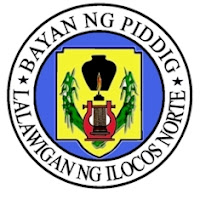This map is availalble in high quality PDF format. Contact me or just click the link below:
https://docs.google.com/file/d/0BzfsqSl-dilRTm1BVzhNOHFjaGc/edit
PIDDIG AS DESCRIBED FROM THE ILOCOS NORTE OFFICIAL PORTAL
PIDDIG
Shield, derived from the Provincial seal of Ilocos Norte
Harp, manifest the love of music of the Piddiguenos
Quill Pen, denotes the Piddiguenos exemplary contribution to Ilocano Literature
Sugar Cane, the source of wine locally produced by the municipality; it also denotes the bountiful glory and success of the famous men of Piddig
Eastern Jar, stands for local wine production prohibited by the Spaniards which led to the famous Piddig Basi Revolt of 1807
Brief History
Piddig is bounded on the west partly by Laoag City and partly by the town of Sarrat; on the north by the Municipality of Vintar; on the south by the town of Solsona and on the east by the Municipality of Carasi. The town occupies an area of 121.33 square kilometres. Despite its proximity to Laoag City, Piddig is sparsely populated. It had a population of 17,797 in 1995.
Piddig is picturesquely spread on the crests and slopes of rolling hills between the Guisit and Baramban rivers. Because of it hilly position, the people called Pidipid which was later changed to Piddig.
The area of what is now Piddig was probably a part of Batak, which was established by the Augustinians on January 15, 1585. It was subsequently elevated into a visita when Dingras was made into a ministry. Finally, it was established as a parish in 1775.
In 1762, the Spanish authorities conscripted the skilled native archers of Piddig known as theTingguian, in the pursuit of Gabriela Silang and her troops who led and continued the armed rebellion after the treacherous death of her husband, Diego Silang. Gabriela was overpowered by the Piddig pursuers and was brought to Vigan where was hanged in October 1763.
During the Philippine Revolution, Piddig was occupied by the revolutionary forces of General Manuel Tinio in August 1898. In Filipino-American War that was to follow, the town became a part of the operational area of Bishop Aglipay’s guerrillas. In 1902, Aglipay established the Philppine Independent Church.
At the height of the World War II, Piddig an dthe surrounding towns became the strong hold of guerrilla resistance against the occuping Japanese forces in Ilocos Norte. It was also in this town that the 15th Infantry USAFFE-NL was formed. This command was responsible for the liberation of the Ilocos Region from the Japanese. Piddig was also made the military capital of Ilocos Norte when the 21st Infantry was stationed there during the early part of war.
Piddig is home to Sgt. Teofilo Ildefonso, a great swimmer and a war hero. A monument has been erected to honor him. The town is also the birthplace of Claro Caluya, the prince of Ilocos poets.
Piddig is basically an agricultural town. Its primary crops are rice, garlic, tobacco, sugarcane, and a variety of vegetables. Its chief cottage industry, which dates back to the Spanish Era, is weaving cloth. The place is known for its blankets, bathrobes, towels, bedsheets, pillows and clothings. The town’s suaco (cigar pipe) is greatly admired for its tide industry.




No comments:
Post a Comment